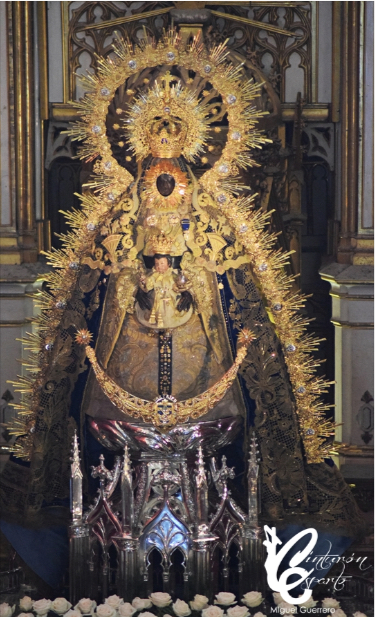
Prayer
Our Sovereign Queen and Mother; Our Lady of the Rule. Trusting in your motherly love for me I humbly kneel before you, the fount of goodness and mercy. Please be my advocate and protector against all ills and miseries. I implore your mercy never to ignore my afflictions that presently torment my soul. Show yourself as a tender mother. Make me your worthy child as I purify my sins through the veneration of your miraculous image of the Rule. Refuse not my petition.
You generously aid and protect those who take refuge from you. Help me to be a humble and grateful child always as I walk along the path of perfection following the steps of your Divine Son. May I rejoice with you in His presence in the everlasting glory of Heaven.
Amen.
Ask for your petition here.
History
The origin of the devotion to the Virgen de la Regla can be traced back to St. Augustine. It was this great saint who hand-carved the first image of the Virgen de Regla and made her the patroness of the Rule of what is the present-day Order of St. Augustine. As a founder, St. Augustine made reglas or rules for the members of his Order to follow. He dedicated these reglas or rules to the Virgin, thus making her the Virgin of the Rule of St. Augustine.
Why is the image of the Virgen de la Regla dark? Contrary to what many people presume, the image of the Virgin is dark not simply because its original statue is made of wood but because its devotion developed in Africa. St. Augustine, who died in the year 430, was from Hippo in north Africa. Since the setting was Africa, the original image was probably made by St. Augustine to harmonize with the color of the people who would be its first devotees. Since most Africans were dark-skinned, a dark-skinned patroness would give them a sense of familiarity and closeness.
Historians distinguish between legend and history. According to legend, the statue of the Virgin de Regla was commissioned by Augustine (354-430) himself and brought by Saint Cyprian, deacon, after the death of Augustine and during the invasion of the Vandals to the southern shores of Spain. The statue found a new home in the seaport city of Chipiona and was venerated in the local monastery by both Augustinian canons and African hermits. In the eighth century the invasion of Andalusia by the Saracens forced the statue to go underground. Indeed, the monks hid the image in a cistern next to a fig tree where she remained until the liberation of the country by Alphonse the Wise in the thirteenth century. In that period, Our Lady manifested herself to a canon regular from León pointing him to the place where the statue lay hidden. The rediscovery of the hidden image, chalice, and burning lamp led to the revival of the devotion to the Virgin de Regla. The cistern and fig tree still exist, and the location is called Humilladero.
From the point of history, the origin of the name appears shrouded in mystery. According to some, the name makes reference to the Rule of the Augustinians. Thus the Virgin would be the protector of the Rule (regla). On the other hand, it is known that Don Alonso Perez de Guzman (~1580-90) erected in Chipiona, a castle by the name of Castillo de Regla.
Source: https://udayton.edu/imri/mary/v/virgin-de-regla.php
